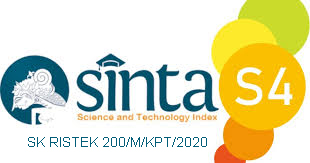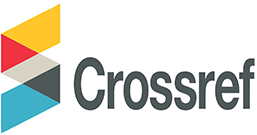The Classification of Anxiety, Depression, and Stress on Facebook Users Using the Support Vector Machine
Abstract
Keywords
Full Text:
PDFReferences
M. Dollarhide, “Social Media Definition,” Investopedia, 2021.
Internet World Stats, “Internet World Stats,” Internet World Stats, 2015.
S. Sujarwoto, G. Tampubolon, and A. C. Pierewan, “A Tool to Help or Harm? Online Social Media Use and Adult Mental Health in Indonesia,” Int. J. Ment. Health Addict., vol. 17, no. 4, pp. 1076–1093, 2019, doi: 10.1007/s11469-019-00069-2.
P. D. Lauren Reining, M.A., Michelle Drouin, “College Students in Distress: Can Social Media be a Source of Social Support?,” Park. Heal. Res. Repos., 2018.
L. Weng and F. Menczer, “Topicality and impact in social media: Diverse messages, focused messengers,” PLoS One, vol. 10, no. 2, pp. 1–17, 2015, doi: 10.1371/journal.pone.0118410.
S. Budury, A. Fitriasari, and K. -, “Penggunaan Media Sosial Terhadap Kejadian Depresi, Kecemasan Dan Stres Pada Mahasiswa,” 2019. doi: 10.36376/bmj.v6i2.87.
E. H. Lee, “Review of the psychometric evidence of the perceived stress scale,” Asian Nurs. Res. (Korean. Soc. Nurs. Sci)., vol. 6, no. 4, pp. 121–127, 2012, doi: 10.1016/j.anr.2012.08.004.
L. Horwitz, “Book Reviews: The Practice of Supportive Psychotherapy.,” J. Am. Psychoanal. Assoc., vol. 36, no. 1, pp. 197–199, 1988, doi: 10.1177/000306518803600115.
D. Carrozzino, C. Patierno, G. A. Fava, and J. Guidi, “The hamilton rating scales for depression: A critical review of clinimetric properties of different versions,” Psychother. Psychosom., vol. 89, no. 3, pp. 133–150, 2020, doi: 10.1159/000506879.
M. HAMILTON, “the Assessment of Anxiety States By Rating,” Br. J. Med. Psychol., vol. 32, no. 1, pp. 50–55, 1959, doi: 10.1111/j.2044-8341.1959.tb00467.x.
S. Verma and A. Mishra, “Depression, anxiety, and stress and socio-demographic correlates among general Indian public during COVID-19,” Int. J. Soc. Psychiatry, vol. 66, no. 8, pp. 756–762, 2020, doi: 10.1177/0020764020934508.
W. Zhang et al., “Diagnostic prediction for social anxiety disorder via multivariate pattern analysis of the regional homogeneity,” Biomed Res. Int., vol. 2015, 2015, doi: 10.1155/2015/763965.
A. Frick et al., “Classifying social anxiety disorder using multivoxel pattern analyses of brain function and structure,” Behav. Brain Res., vol. 259, pp. 330–335, 2014, doi: 10.1016/j.bbr.2013.11.003.
S. P. Pantazatos, A. Talati, F. R. Schneier, and J. Hirsch, “Reduced anterior temporal and hippocampal functional connectivity during face processing discriminates individuals with social anxiety disorder from healthy controls and panic disorder, and increases following treatment,” Neuropsychopharmacology, vol. 39, no. 2, pp. 425–434, 2014, doi: 10.1038/npp.2013.211.
V. Kecman, “Support Vector Machines – An Introduction 1 Basics of Learning from Data,” StudFuzz, vol. 177, pp. 1–47, 2005.
V. N. Vapnik, Statistics for Engineering and Information Science Springer Science+Business Media, LLC. 2000.
DOI: https://doi.org/10.31326/jisa.v5i1.1273
Refbacks
- There are currently no refbacks.
Copyright (c) 2022 Tsania Maulidia Wijiasih, Rona Nisa Sofia Amriza, Dedy Agung Prabowo

This work is licensed under a Creative Commons Attribution-ShareAlike 4.0 International License.
JOURNAL IDENTITY
Journal Name: JISA (Jurnal Informatika dan Sains)
e-ISSN: 2614-8404, p-ISSN: 2776-3234
Publisher: Program Studi Teknik Informatika Universitas Trilogi
Publication Schedule: June and December
Language: English
APC: The Journal Charges Fees for Publishing
Indexing: EBSCO , DOAJ, Google Scholar, Arsip Relawan Jurnal Indonesia, Directory of Research Journals Indexing, Index Copernicus International, PKP Index, Science and Technology Index (SINTA, S4) , Garuda Index
OAI address: http://trilogi.ac.id/journal/ks/index.php/JISA/oai
Contact: jisa@trilogi.ac.id
Sponsored by: DOI – Digital Object Identifier Crossref, Universitas Trilogi
In Collaboration With: Indonesian Artificial Intelligent Ecosystem(IAIE), Relawan Jurnal Indonesia, Jurnal Teknologi dan Sistem Komputer (JTSiskom)
JISA (Jurnal Informatika dan Sains) is Published by Program Studi Teknik Informatika, Universitas Trilogi under Creative Commons Attribution-ShareAlike 4.0 International License.


















